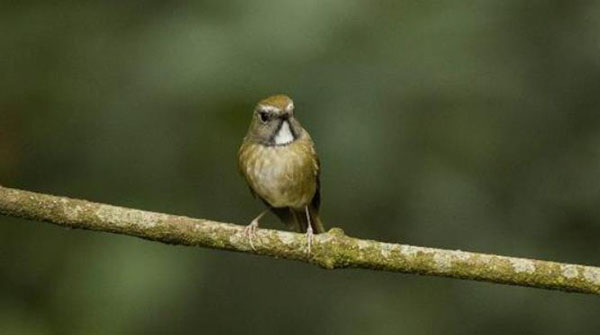
1. White-throated buzzard (scientific name: Buteoalbigula): White-throated buzzard is a falcon-like creature of the order Falconidae, distributed in South America, including Colombia, Venezuela, Guyana, Suriname, Ecuador, Peru, Bolivia, Paraguay, Brazil, Chile, Argentina, Uruguay and the Malvinas Islands (also known as the Falkland Islands).
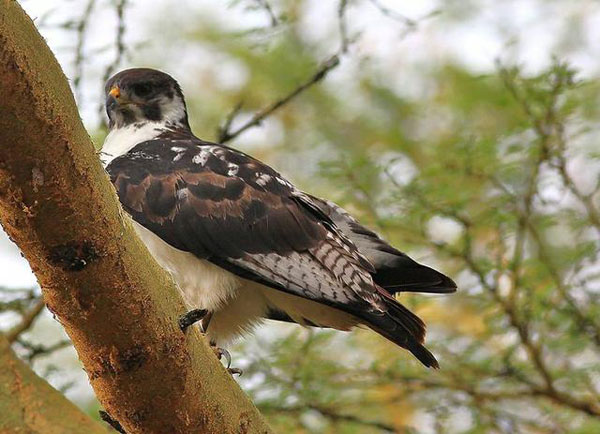
2. African buzzard (scientific name: Buteo augur): body length 55-60 cm, wingspan 132 cm, weight 11-13 kg. It is a large vulture with very broad wings. This species has two different color forms, light and dark. The adult bird of the dark type is dark gray, with the upper body almost entirely black. The flight feathers are black and the secondary flight feathers have light gray stripes. The tail is reddish brown with a faint dark gray stripe. The underparts are white, including the wing coverts, but there are black patches on the shoulder corners. It lives in hilly and mountainous areas, ranging from sea level to altitudes above 1,000 meters. Feeds mainly on reptiles such as lizards and snakes, rodents and moles, small birds, insects and carrion.
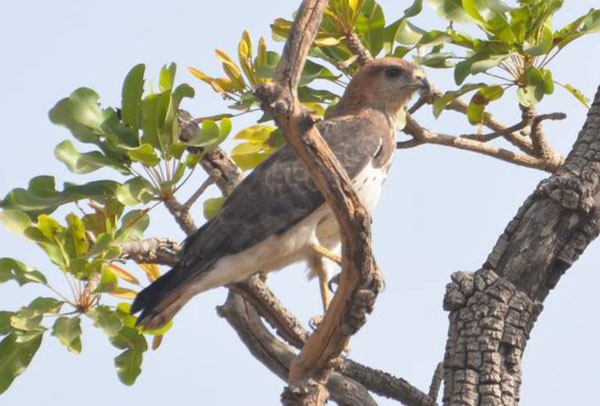
3. Red-necked buzzard (scientific name: Buteo auguralis): body length 42-50 cm, weight 525-890 g. As its name suggests, the most obvious feature of this medium-sized raptor is the prominent reddish-brown color on its neck, which extends from its crown to its upper back. The rest of the upper body feathers are mainly black, except for the tail feathers, which are also reddish brown and marked with black stripes at the end of the tail. Occurs in plantations, farming areas, savannas, and inhabits altitudes up to 2,500 meters. Prey consists of a variety of small animals including rodents, birds, lizards, snakes, and arthropods.
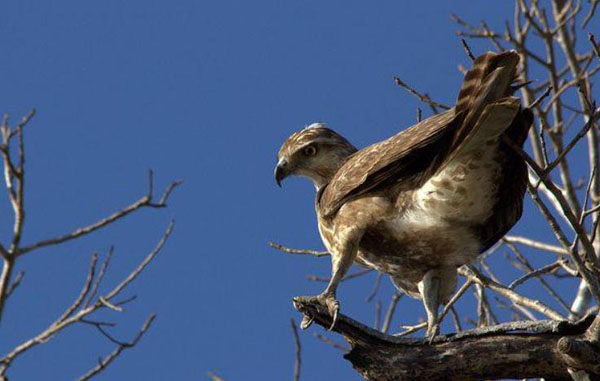
4. Madagascar Buzzard (scientific name: Madagascar Buzzard): It is a medium-sized raptor with a body length of 51 cm and a wingspan of 93-110 cm. There is an arc-shaped vertical process at the end of the upper beak, which is suitable for tearing and swallowing prey; the base is equipped with wax film or whisker-like feathers; the wings are strong, broad, round and blunt, and they flap and soar with a slower rhythm than those of the Falconidae; tarsus The metatarsal part is mostly relatively long, approximately equal to the length of the shin. Inhabits the edges of forests and secondary forests. Mostly feed on small to medium-sized vertebrates.
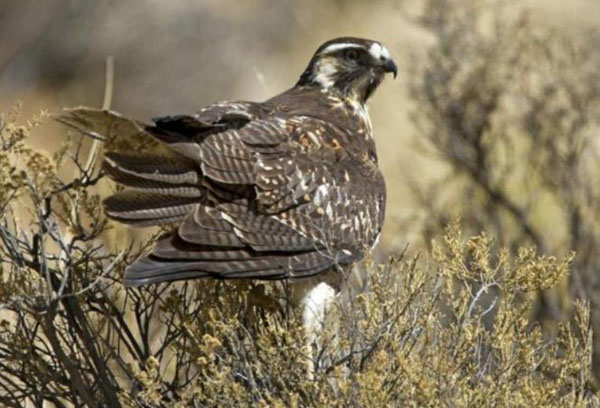
5. Short-tailed buzzard (scientific name: Buteo brachyurus): It is a smaller bird of the genus buzzard. Body length 39-44 cm, wingspan 83-103 cm. Tail length 13.2-34 cm. Weighing 392-515 grams, females are larger than males, but the appearance of both sexes is similar. When perched, the wings reach the tip of the tail. Because it has a very short tail, it is called the short-tailed buzzard. The beak is black, the legs and feet are light yellow to lemon yellow, and the claws are black. Short-tailed eagles come in two forms, light and dark. It has broad wings and a short, rounded tail. It preys primarily on smaller birds, but also lizards, snakes, rodents, and occasionally insects, including wasps and grasshoppers. Distributed in New Taipei and Neotropical areas.

6. The common buzzard (scientific name: Buteo buteo) is a medium-sized raptor with a body length of 50-59 cm. The body color changes greatly, the upper body is mainly dark brown, the lower body is mainly dark brown or light brown, with dark brown horizontal spots or vertical stripes, and the tail is light grayish brown with multiple dark horizontal spots. When flying, the wings are broad, with obvious white spots at the base of the primary flight feathers, and white under the wings. Only the wing tips, wing angles and outer edges of the flight feathers are black (light type) or all dark brown (dark type). The tail is spread out in a fan shape. When flying, the wings are slightly raised upward into a shallow 'V' shape. It mainly inhabits mountain forests and forest edge areas, ranging from broad-leaved forests at the foot of mountains at an altitude of 400 meters to mixed forests and coniferous forests at 2,000 meters. It is common in open plains, deserts, wilderness, reclaimed farming areas, and forest edges. Soaring over meadows and villages. Feeds on forest rats.
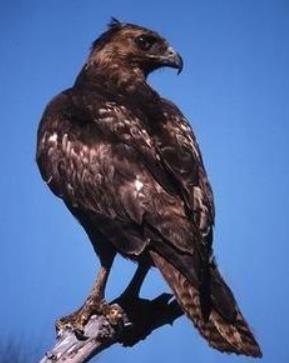
7. Galapagoensis (scientific name: Buteo galapagoensis) is a huge raptor of the genus Buteo. The body length is about 55 cm, and the wingspan is quite large, reaching 120 cm. Sexual dimorphism, with females significantly larger than males. Adult feathers are black. The head is slightly darker. The chest is pale and the sides and belly are red. There are dark brown spots on the body, and white spots often appear on the back. Have strong legs. It has a slender tail, which is brown and white, with slight stripes on its tail feathers. Like other buzzards of its genus, the Galapagos buzzard has excellent eyesight. The iris is brown, and the soft skin of the legs, cere, and base of the bill is yellow.
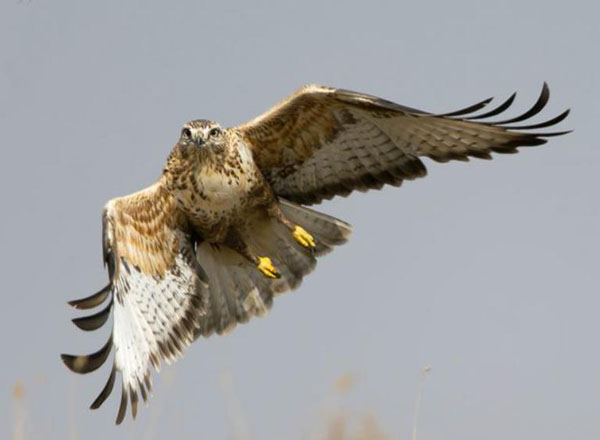
8. The great buzzard (scientific name: Buteo hemilasius) is a bird of the genus Buteo in the family Accipitridae. It is a large raptor with a body length of 570-760 mm. The top of the head and back of the neck are white, with brown vertical stripes running through each feather. The side of the head is white; there are brown mustache stripes, the upper body is light brown, there are 3-9 dark horizontal spots, and the feather trunks are white; the lower body is mostly brown and white; the front of the tarsometatarsus is usually feathered, and there are white spots under the wings when flying. The iris is yellowish brown, the mouth is black, the wax membrane is yellowish green, the tarsometatarsus and toes are yellow, and the claws are black. The vertical distribution height can reach plateaus and mountainous areas of more than 4,000 meters. Likes to rest on tall trees or tall objects. It mainly feeds on rodents, frogs, lizards, hares, snakes, chinchillas, pikas, marmots, pheasants, stone chickens, insects and other animal foods.
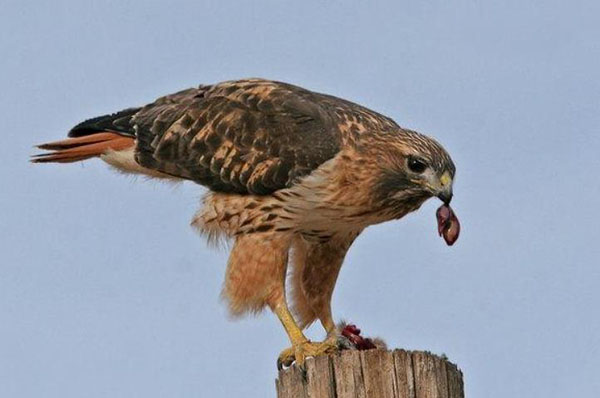
9. Red-tailed buzzard (scientific name: Buteo jamaicensis): The wingspan of the red-tailed buzzard is 114-133 cm; its lifespan is 22 years. Males weigh 690-1300 grams and have a body length of 45-56 centimeters, while females weigh 900-2000 grams and have a body length of 50-65 centimeters; therefore, female birds are usually larger than males. There is an arc-shaped vertical process at the end of the upper beak, which is suitable for tearing and swallowing prey; the base is equipped with wax film or whisker-like feathers; the wings are strong, broad, round and blunt, and they flap and soar with a slower rhythm than those of the Falconidae; tarsus The metatarsal part is mostly relatively long, approximately equal to the length of the shin. Food mainly includes various small mammals, birds and reptiles, such as rodents, grouse, quail, water birds, bats, shrews, snakes, lizards, crustaceans, insects, etc. They can be found throughout most of North America except the Arctic.
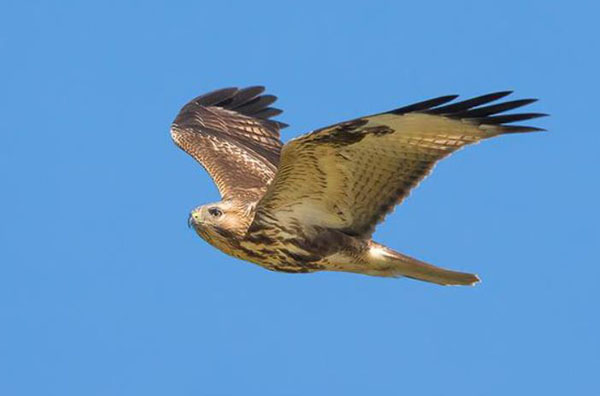
10. Japanese buzzard (scientific name: Buteo japonicus): It is a medium-sized raptor with a body length of 42-54 cm and a wingspan of 122-137 cm. The male weighs 630-810 grams and the female weighs 515-970 grams. The upper body is dark reddish brown; the skin on the side of the face is yellow with almost red fine lines, and the maroon mustache pattern is obvious; the lower body is mainly dark brown or light brown, with dark brown horizontal spots or vertical stripes, and the tail feathers are light gray brown with multiple dark horizontal stripes. Spotted, the wings are broad when flying, with obvious white spots at the base of the primary flight feathers, and the underwings are flesh-colored. Only the wing tips, wing angles and outer edges of the flight feathers are black (light type) or all dark brown (dark type). The tail feathers fan out. When soaring at high altitude, the wings are slightly V-shaped. It is distributed from the broadleaf forest at the foot of the mountain at an altitude of 400 meters to the mixed forest and coniferous forest at an altitude of 2,000 meters. It is often found hovering over open plains, deserts, wilderness, cultivated areas, forest edge grasslands and villages. Feeds on forest rats.
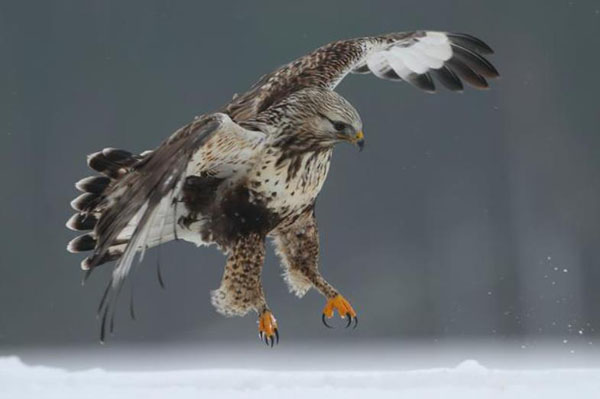
11. Hairy-footed buzzard (scientific name: Buteo lagopus): Also known as snow-white leopard and hairy-footed buzzard, it is named after its rich feathers covering its toes. It is a rare winter migratory bird and migratory bird. Weight 650-1100 grams. Like common buzzard. The upper body is dark brown, and the lower back and shoulders are often decorated with almost white irregular horizontal bands. The tail coverts often have white horizontal spots, which are round but not branched. The hairy-footed buzzard mainly inhabits areas near the Arctic during the breeding season and is a relatively cold-resistant tundra coniferous forest bird. It mainly feeds on small rodents and small birds such as voles, and also preys on larger animals such as hares, pheasants, and pheasants, females and young birds. Distributed throughout the North.

12. Red-shouldered buzzard (scientific name: Buteo lineatus): It is a medium-sized raptor with a body length of 47 cm, a wingspan of 90-114 cm, and a weight of 500-700 grams. The upper body is usually dark brown, white or gray; the shoulders are chestnut red with reddish wing linings; the lower body, chest and abdomen are red with light red stripes; the feathers on the lower abdomen and legs are light yellow to gray, and the tail feathers are brown Brown, usually with 4-6 distinct white horizontal bars. The red-shouldered buzzard inhabits a variety of North American forests and preys on small mammals, birds, reptiles and amphibians. It mainly feeds on hares, rodents, frogs, lizards, snakes, pheasants and other birds and bird eggs. Sometimes it also eats dead fish and other animal carcasses.
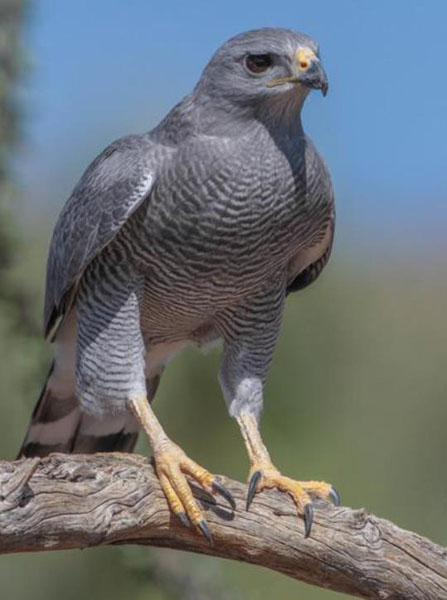
13. Gray-striped buzzard (scientific name: Buteo nitidus): It is a medium-sized raptor with a body length of 46-61 cm and a weight of 475 grams. It has a powerful body and broad wings. Broad wings, broad tail. The body feathers are usually light gray, with fine stripes on the upper body, and the tail is black with three white stripes. When flying, the wings are slightly raised upward into a shallow 'V' shape. White rump, dark brown eyes, yellow paws with wax film. The upper body of the young bird is dark brown, the tail feathers are light brown, the belly is white with brown spots, and the head and neck have brown stripes. Mainly inhabit mountain forests, sparse trees and riparian forests, forest edge zones, and semi-arid areas. In addition to rodents, they also eat animal foods such as frogs, lizards, snakes, hares, small birds and large insects. Sometimes they also go to villages to hunt chickens and other poultry. <

14. Mountain buzzard (scientific name: Buteo oreophilus): The mountain buzzard is 45 cm long and weighs 700 grams. The appearance is very similar to that of the common buzzard subspecies, usually the upper body is brown; the skin on the side of the face is yellow with almost red lines, and the maroon mustache pattern is obvious; the black marks are much less. But the lower body is whiter, and the chest, abdomen and flanks are evenly covered with a large number of brown spots. The flanks and thighs are stained brown. Mainly inhabit mountain forests, forest edge zones, forest patches, including plantations of exotic trees such as eucalyptus. It mainly feeds on small mammals. In addition to rodents, it also eats animal foods such as frogs, lizards, snakes, hares, small birds and large insects.
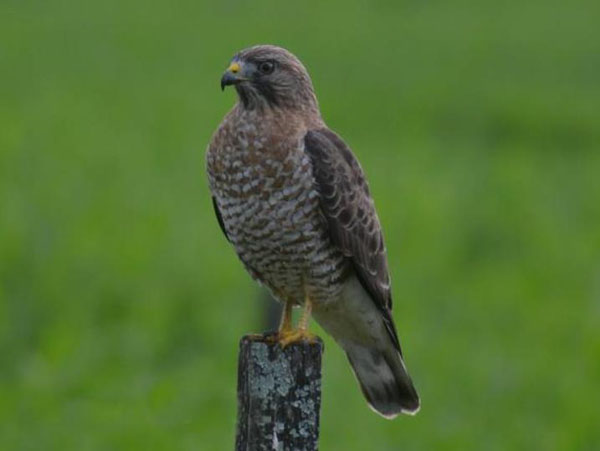
15. Giant-winged buzzard (scientific name: Buteo platypterus): Giant-winged buzzard is a small and stout eagle. The body length is 34-44 cm, the wingspan is 81-100 cm, and the weight is 265-560 grams. The upper body and back of the adult bird are dark brown, and the lower body is pale with horizontal cinnamon or maroon markings. The tail is dark gray to black with a distinct broad white stripe in the middle. When perched, the wing tips do not reach the end of the tail. Mainly chipmunks, shrews and voles as well as frogs and lizards. In winter, most of the food consists of insects, lizards, frogs, snakes, crabs, and small mammals. Mammals are eaten whole. Frogs and snakes were skinned and birds were plucked.
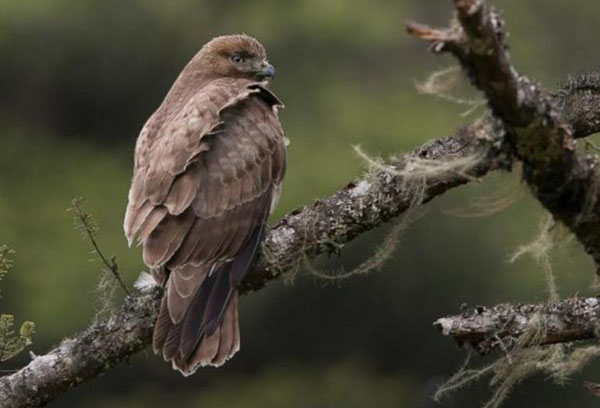
16. Himalayan buzzard (scientific name: Buteo refectus): The Himalayan buzzard is a medium-sized raptor, with a body length of 45-53 cm and a wingspan of 112-118 cm. Weight 575-1073 grams. The upper body is dark reddish brown; the skin on the side of the face is yellow with almost red fine lines, and the maroon mustache pattern is obvious; the lower body is mainly dark brown or light brown, with dark brown horizontal spots or vertical stripes, and the tail feathers are light gray brown with multiple dark horizontal stripes. Spotted, the wings are broad when flying, with obvious white spots at the base of the primary flight feathers, and the underwings are flesh-colored. Only the wing tips, wing angles and outer edges of the flight feathers are black (light type) or all dark brown (dark type). The tail feathers fan out. When flying at high altitude, the wings are slightly V-shaped. It mainly inhabits mountain forests and forest edge areas, ranging from broad-leaved forests at the foot of mountains at an altitude of 400 meters to mixed forests and coniferous forests at 2,000 meters. It is common in open plains, deserts, wilderness, reclaimed farming areas, and forest edges. Soaring over meadows and villages. Feeds on forest rats.

17. Gray buzzard (scientific name: Buteo plagiatus): The gray buzzard is a medium-sized raptor, 41-44 cm, the male bird weighs 391-470 g, the female bird weighs 552-688 g, and the wingspan is 89 cm. [2] Has a powerful body and broad wings. Broad wings, broad tail. The body feathers of the adult bird are light gray, with no pattern on the upper body, and light gray on the lower body, with fine stripes. The tail is black with three white stripes. When flying, the wings are slightly raised upward into a shallow 'V' shape. White rump, dark brown eyes, orange legs, wax film on the paws. They often live alone or in pairs in open, rocky and dry barren lands. They mainly feed on forest rats and eat a lot of food. In addition to rodents, they also eat animal foods such as frogs, lizards, snakes, hares, small birds and large insects. Sometimes they also go to villages to hunt chickens and other poultry.
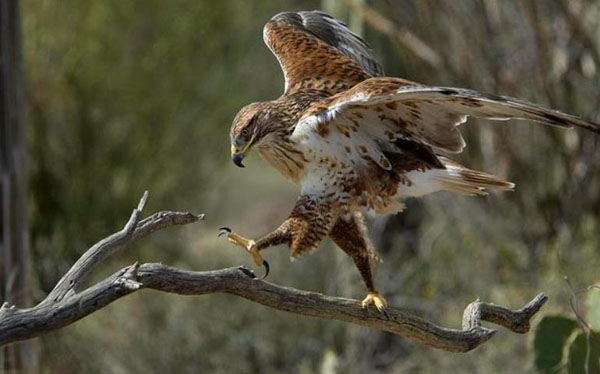
18. Wang buzzard (scientific name: Buteo regalis): body length 50-66 cm, wingspan 134-152 cm, weight 980-2030 grams. It is the largest hawk in North America. Adult birds have a rusty red color on their backs and shoulders that extends down to their legs. The underparts are white with some reddish-brown markings. The bird can be seen in flight showing the leg feathers forming a V shape with the king buzzard's abdomen. The king buzzard is a carnivore. Usually flying low over open fields, soaring high, wandering or swooping down from their habitat. They use their excellent eyesight to spot prey on the ground and attack with their claws. They hunt ground squirrels, jackrabbits, mice, birds, reptiles and amphibians for food.
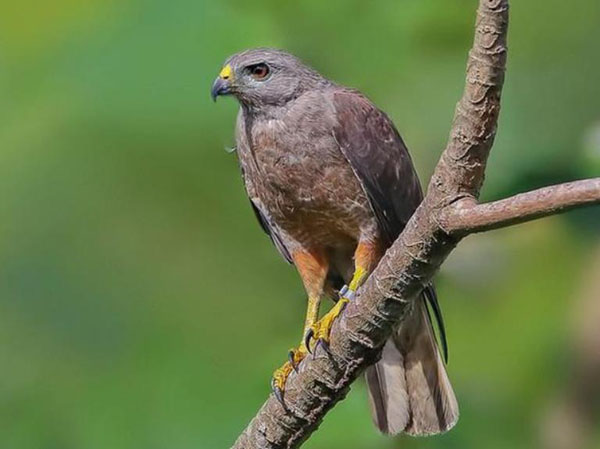
19. Richter's buzzard (scientific name: Buteo ridgwayi): It is a small to medium-sized buzzard with a body length of 36-41 cm and a wingspan of 69-81 cm. The male buzzard has a grayish-brown head and bright red shoulders. The head and neck are gray and the throat is white. The upper body of the adult bird is gray and black, and the lower body is gray with white stripes and fine reddish brown spots. Light auburn thighs and black and white striped tail feathers. The wings are dark brown with mottled patterns, the claws are golden yellow, the upper part of the beak has a yellow base and a black tip; the lower part of the beak is gray. The iris is amber with white circles. Mainly lives in moist forests covered with limestone. Feeds mainly on small mammals, birds, lizards and snakes.
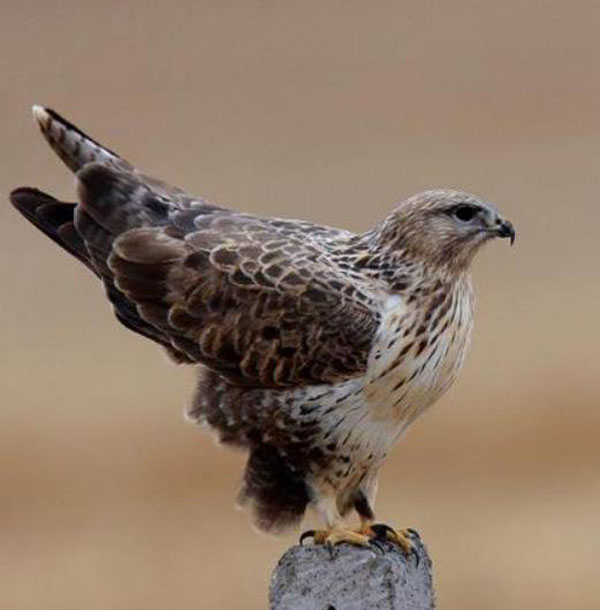
20. Brown-tailed buzzard (scientific name: Buteo rufinus): It is a medium-to-large raptor of the genus Accipitridae, with a body length of 50-65 cm and a weight of 1280 grams. The head and neck of the adult bird are brown, and the upper body is brown; the outer part of the 2nd to 5th primary flight feathers has horizontal spots; the lower body is brown and white; the tail is brown, which is different from other species of buzzards. When flying, the wings are raised in a "V" shape with black wingtips. It mainly feeds on hares, rodents, frogs, lizards, snakes, pheasants and other birds and bird eggs. Sometimes it also eats dead fish and other animal carcasses. Often active alone. They often stand on rocks and mounds waiting to find prey on the ground.
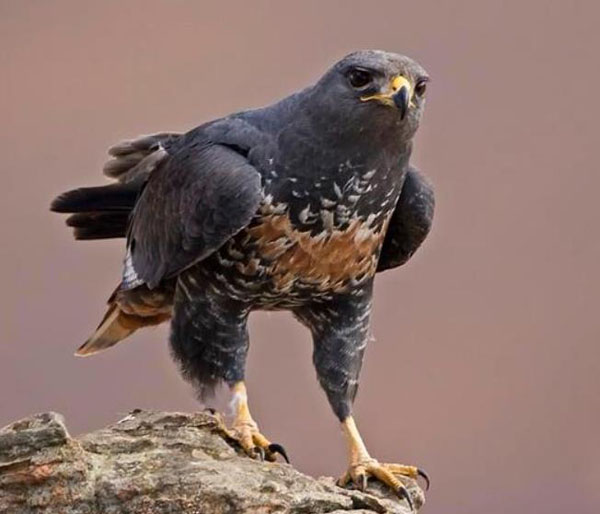
21. Dark brown buzzard (scientific name: Buteo rufofuscus): body length 55 cm, wingspan 127-143 cm, weight 790-1370 g. It is a large squatting buzzard with black and red feathers. The crown, head and throat are black slate, and the rump and tail are bright red. The remaining flight feathers show a pale area. The back feathers have red or white demarcations. There is a rough, irregular white line decorating the base of the black throat. The abdomen is black with white stripes. The anal area is reddish. Habitats include mountains, mountains, rugged valleys, steep rocks, alpine meadows and desert scrub. Carnivorous, feeding on mammals, especially rodents, but also reptiles such as lizards and snakes. Occasionally they eat birds, insects (flying termites and grasshoppers), and carrion.
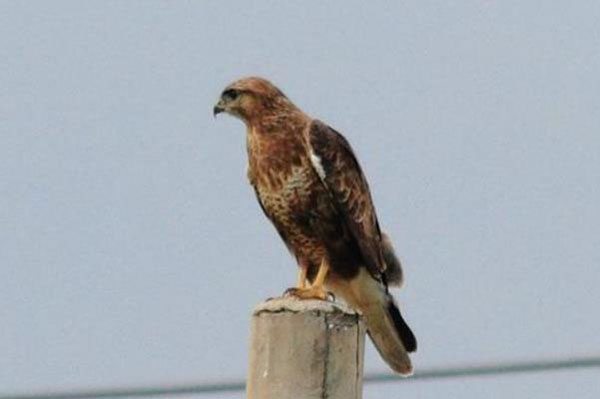
22. Socotra Island buzzard (scientific name: Buteo socotraensis): It is a medium-sized raptor, with a body length of 43-49 cm and a weight of 500-1000 grams. There is an arc-shaped vertical process at the end of the upper beak, which is suitable for tearing and swallowing prey; the base is equipped with wax film or whisker-like feathers; the wings are strong, broad, round and blunt, and they flap and soar with a slower rhythm than those of the Falconidae; tarsus The metatarsal part is mostly relatively long, approximately equal to the length of the shin. Lives on the edge of the forest. Feeds mostly on small to medium-sized vertebrates. They mainly feed on forest rats. In addition to rodents, they also eat animal foods such as frogs, lizards, snakes, hares, small birds and large insects. Sometimes they also go to villages to hunt chickens and other poultry.
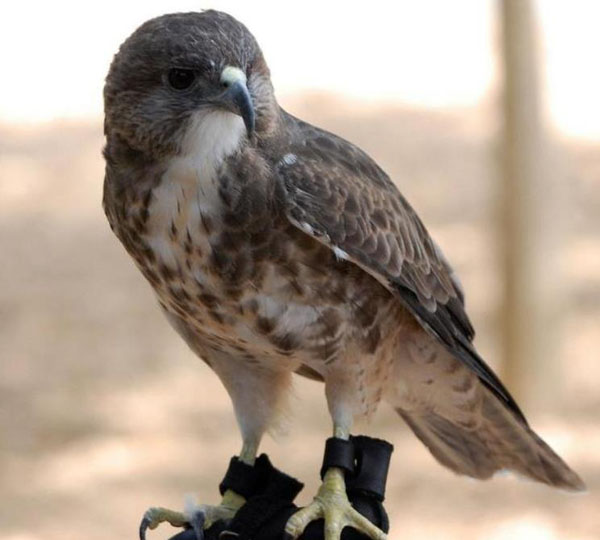
23. Hawaiian buzzard (scientific name: Buteo solitarius): body length 46 cm, wingspan 87-101 cm, weight 441 grams. It is a small, broad-winged raptor that comes in two colors. Dark and light forms, as well as a wide range of intermediate plumage colors and individual variations. The body color changes greatly, the upper body is mainly dark brown, and the lower body is dark brown or light brown. The wax film is blue and the legs are greenish-yellow. Seen hovering over open plains, deserts, wilderness, cultivated areas, forest edge grasslands and villages. Most of them move alone, but sometimes 2-4 can be seen circling in the sky. It has an alert temperament and keen vision. It lives in mountain forests and forest edge areas. It feeds on various rodents, frogs, lizards, snakes, hares, small birds and large insects.
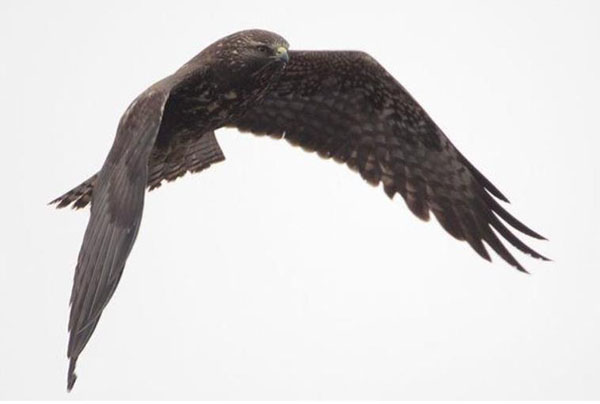
24. Swainsoni's buzzard (scientific name: Buteo swainsoni) is a large-shaped buzzard. The body length is 50-56 cm, the wingspan is 117-137 cm, the weight is 820-1130 grams, and the life span is 16 years. Slightly smaller than the red-tailed buzzard. Its wingspan is slightly longer than other buzzards, and its wings are slender. When flying, their wings form two planes, and the wing tips swing slightly forward and back when they are tall. There is an arc-shaped vertical process at the end of the upper beak, which is suitable for tearing and swallowing prey; the base is equipped with wax film or whisker-like feathers; the wings are strong, broad, round and blunt, and they flap and soar with a slower rhythm than those of the Falconidae; tarsus The metatarsal part is mostly relatively long, approximately equal to the length of the shin. Swain's buzzard inhabits the prairies and arid grasslands of western North America. When it comes to eating insects, it likes to eat insects of the family Acrididae. Also eats small mammals, birds, reptiles and amphibians.
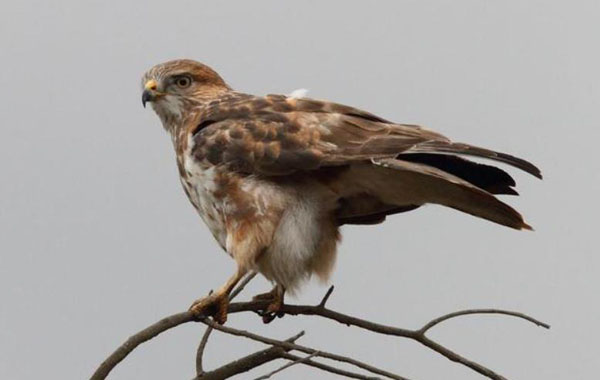
25. Forest buzzard (scientific name: Buteo trizonatus): body length 45 cm, weight 700 grams. Once another subspecies of the mountain buzzard, it was classified as an independent species in 2014. The appearance is very similar to that of the common buzzard subspecies, usually brown on the upper body; but the lower body is whiter, and the chest, abdomen and flanks are evenly covered with a large number of brown spots. The flanks and thighs are stained brown. In flight, the wings are wide and rounded. The upper tail coverts are brown, the lower coverts are light gray, and the tail end has narrow black stripes. When soaring at high altitude, the wings are slightly V-shaped. The iris is grey-brown; the mouth is gray, the tip is black, the wax membrane is yellow; the feet are yellow. It mainly inhabits mountain forests and forest edge zones, patchy forests, including plantations of exotic trees such as eucalyptus. It mainly feeds on small mammals. In addition to rodents, it also eats animal foods such as frogs, lizards, snakes, hares, small birds and large insects. Distributed in South Africa.
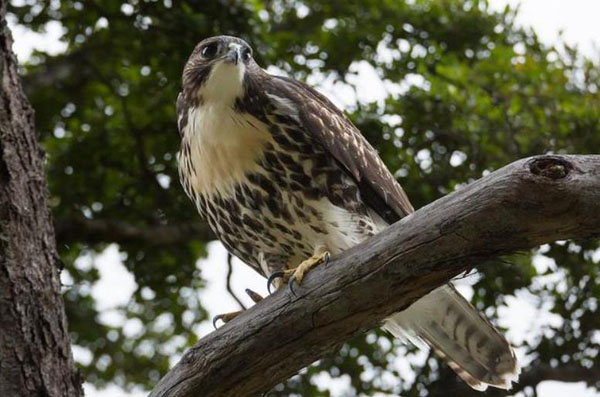
26. American brown-tailed buzzard (scientific name: Buteo ventralis): body length 54-60 cm, wingspan 119-139 cm, weight 950 grams. It is a relative body shapeLarger raptor with long, slender, square-pointed wings and very powerful claws. The back is dark brown, the throat is white, the belly is ocher with dark brown stripes and spots, and these black spots are more abundant on the sides. The wings are long and broad. The tail is white with slight traces of gray. The thighs are cinnamon and dark yellow. There are two different color types, the light type is more common and the dark type is less common. Perched on a tree branch or fence post, it swoops down and catches its prey. Mainly feeds on birds, but also eats small mammals, reptiles and beetles.
animal tags: buzzard
We created this article in conjunction with AI technology, then made sure it was fact-checked and edited by a Animals Top editor.